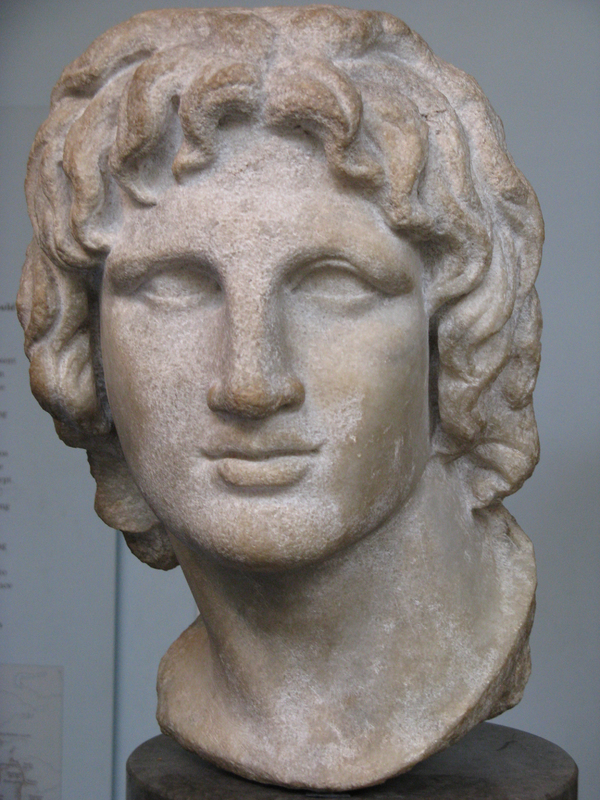BM Head of Alexander the Great
Title
BM Head of Alexander the Great
Date
late 2nd century BC, Hellenistic
Artist or Workshop
Unknown
Materials
marble
Height of the work
37 cm
Provenience
Egypt, Lower Egypt, Nile Delta, Alexandria
Current Location
British Museum
Sitter Biography
This is a bust of Alexander III of Greece, more commonly known as Alexander the Great. He was born in 356 BC and is the son of Philip II of Macedon and Olympias. Both of his parents were considered descendants of Greek gods or heroes and thus Alexander has godly ancestors. He was taught by Greek tutors and philosophers including Aristotle. In 334 BC he become the leader of the League of Corinth and he led the army on an extensive campaign throughout Greece, Persia, and Asia Minor. During his campaign he was very successful in battles against the Persians and others becoming well known across Asia Minor and into Egypt as well. One of the legacies of his campaign are the numerous cities named "Alexandria" across the area. He died while on campaign in Babylon when he was only 33 years old.
Description and Significance
Description-
This is a bust of Alexander the Great done in the Lysippan style. He has a smooth, youthful face with parted lips and a "melting" glance in the eyes. He has long hair pushed out of his face and up above his forehead in the anastole or cowlick style. Even though we cannot see the rest of his body we can tell that there is a dynamic twist of the head and his gazed is turned upward.
While the front of the bust looks mostly clean cut the back does not appear to be completely finished or has been damaged over time. There is no modeling for hair on the back It is believed that the bust may have been attached to a separate body. One can infer that they body was probably a youthful, godlike figure.
Significance-
This bust is important first and foremost because of the success and power of Alexander the Great. If he had just been another mediocre, or inadequate, leader then there would not be as much emphasis put on his portraits. Portraits of Alexander are also important because he was very concerned with his image and therefore had a team of artists that could depict his likeness, sort of like a PR committee. His sculptor was Lysippos, whose style was copied in this posthumous portrait of Alexander. Alexander wanted to be shown as a divine hero for Greece and all of his portraits show him looking the same way even as he aged. This does not seem that strange to us at first because when we think of portraits today we think of photographs that show someone exactly as they are. However we also see age today and we do not know for sure if these pictures are exactly what Alexander looked like or how he wanted people to think he looked. It is consistent with how he was described in writing from the time period.
This is a bust of Alexander the Great done in the Lysippan style. He has a smooth, youthful face with parted lips and a "melting" glance in the eyes. He has long hair pushed out of his face and up above his forehead in the anastole or cowlick style. Even though we cannot see the rest of his body we can tell that there is a dynamic twist of the head and his gazed is turned upward.
While the front of the bust looks mostly clean cut the back does not appear to be completely finished or has been damaged over time. There is no modeling for hair on the back It is believed that the bust may have been attached to a separate body. One can infer that they body was probably a youthful, godlike figure.
Significance-
This bust is important first and foremost because of the success and power of Alexander the Great. If he had just been another mediocre, or inadequate, leader then there would not be as much emphasis put on his portraits. Portraits of Alexander are also important because he was very concerned with his image and therefore had a team of artists that could depict his likeness, sort of like a PR committee. His sculptor was Lysippos, whose style was copied in this posthumous portrait of Alexander. Alexander wanted to be shown as a divine hero for Greece and all of his portraits show him looking the same way even as he aged. This does not seem that strange to us at first because when we think of portraits today we think of photographs that show someone exactly as they are. However we also see age today and we do not know for sure if these pictures are exactly what Alexander looked like or how he wanted people to think he looked. It is consistent with how he was described in writing from the time period.
References
Pollitt, J.J. 1986. Art in the Hellenistic Age, Cambridge.
http://www.britishmuseum.org/research/collection_online/collection_object_details.aspx?assetId=1612920373&objectId=460442&partId=1
http://www.britishmuseum.org/research/collection_online/collection_object_details.aspx?assetId=1612920373&objectId=460442&partId=1
Contributor
Nina Cardillo
Citation
Unknown, “BM Head of Alexander the Great,” Digital Portrait "Basket" - ARTH488A - "Ancient Mediterranean Portraiture", accessed June 6, 2025, https://classicalchopped2.artinterp.org/omeka/items/show/54.
Item Relations
This item has no relations.

